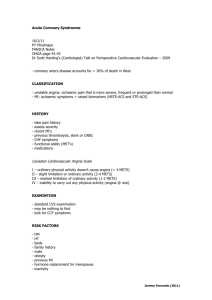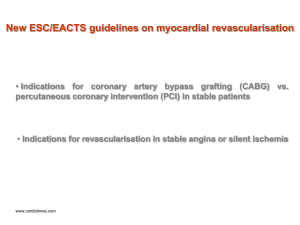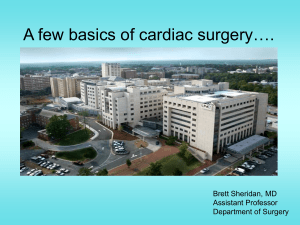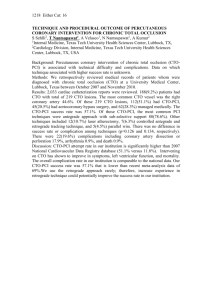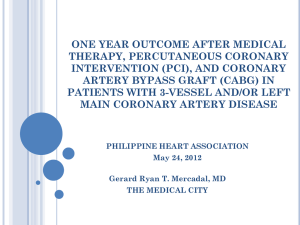Participating Centers Data collection was carried out at 44 centers
advertisement
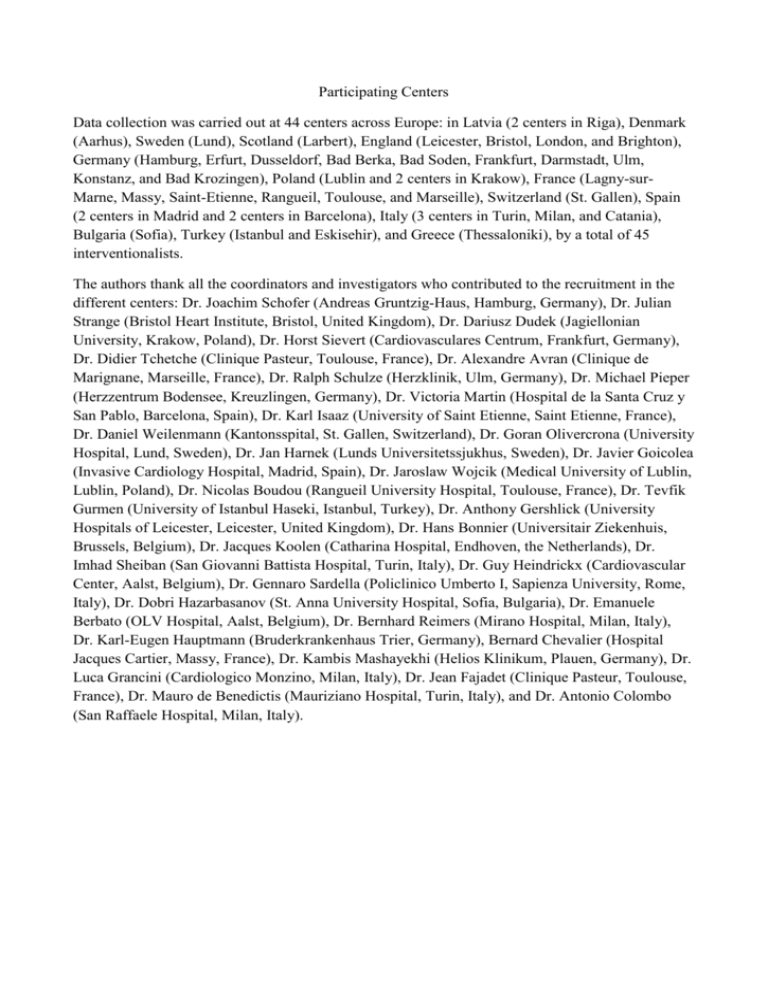
Participating Centers Data collection was carried out at 44 centers across Europe: in Latvia (2 centers in Riga), Denmark (Aarhus), Sweden (Lund), Scotland (Larbert), England (Leicester, Bristol, London, and Brighton), Germany (Hamburg, Erfurt, Dusseldorf, Bad Berka, Bad Soden, Frankfurt, Darmstadt, Ulm, Konstanz, and Bad Krozingen), Poland (Lublin and 2 centers in Krakow), France (Lagny-surMarne, Massy, Saint-Etienne, Rangueil, Toulouse, and Marseille), Switzerland (St. Gallen), Spain (2 centers in Madrid and 2 centers in Barcelona), Italy (3 centers in Turin, Milan, and Catania), Bulgaria (Sofia), Turkey (Istanbul and Eskisehir), and Greece (Thessaloniki), by a total of 45 interventionalists. The authors thank all the coordinators and investigators who contributed to the recruitment in the different centers: Dr. Joachim Schofer (Andreas Gruntzig-Haus, Hamburg, Germany), Dr. Julian Strange (Bristol Heart Institute, Bristol, United Kingdom), Dr. Dariusz Dudek (Jagiellonian University, Krakow, Poland), Dr. Horst Sievert (Cardiovasculares Centrum, Frankfurt, Germany), Dr. Didier Tchetche (Clinique Pasteur, Toulouse, France), Dr. Alexandre Avran (Clinique de Marignane, Marseille, France), Dr. Ralph Schulze (Herzklinik, Ulm, Germany), Dr. Michael Pieper (Herzzentrum Bodensee, Kreuzlingen, Germany), Dr. Victoria Martin (Hospital de la Santa Cruz y San Pablo, Barcelona, Spain), Dr. Karl Isaaz (University of Saint Etienne, Saint Etienne, France), Dr. Daniel Weilenmann (Kantonsspital, St. Gallen, Switzerland), Dr. Goran Olivercrona (University Hospital, Lund, Sweden), Dr. Jan Harnek (Lunds Universitetssjukhus, Sweden), Dr. Javier Goicolea (Invasive Cardiology Hospital, Madrid, Spain), Dr. Jaroslaw Wojcik (Medical University of Lublin, Lublin, Poland), Dr. Nicolas Boudou (Rangueil University Hospital, Toulouse, France), Dr. Tevfik Gurmen (University of Istanbul Haseki, Istanbul, Turkey), Dr. Anthony Gershlick (University Hospitals of Leicester, Leicester, United Kingdom), Dr. Hans Bonnier (Universitair Ziekenhuis, Brussels, Belgium), Dr. Jacques Koolen (Catharina Hospital, Endhoven, the Netherlands), Dr. Imhad Sheiban (San Giovanni Battista Hospital, Turin, Italy), Dr. Guy Heindrickx (Cardiovascular Center, Aalst, Belgium), Dr. Gennaro Sardella (Policlinico Umberto I, Sapienza University, Rome, Italy), Dr. Dobri Hazarbasanov (St. Anna University Hospital, Sofia, Bulgaria), Dr. Emanuele Berbato (OLV Hospital, Aalst, Belgium), Dr. Bernhard Reimers (Mirano Hospital, Milan, Italy), Dr. Karl-Eugen Hauptmann (Bruderkrankenhaus Trier, Germany), Bernard Chevalier (Hospital Jacques Cartier, Massy, France), Dr. Kambis Mashayekhi (Helios Klinikum, Plauen, Germany), Dr. Luca Grancini (Cardiologico Monzino, Milan, Italy), Dr. Jean Fajadet (Clinique Pasteur, Toulouse, France), Dr. Mauro de Benedictis (Mauriziano Hospital, Turin, Italy), and Dr. Antonio Colombo (San Raffaele Hospital, Milan, Italy). Supplemental Table 1: Procedural complications and in-hospital outcomes in retrograde and antegrade lesions during the study period (2008-2012). RETROGRADE ANTEGRADE P value (N=1582) (N=8007) Procedural complications 108 (6.8) 310 (3.9) <0.0001 PE - without tamponade 9 (0.6) 6 (0.1) <0.0001 PE- with tamponade 15 (1.0) 21 (0.3) <0.0001 PE - Surgical intervention 2 (0.1) 2 (0.02) 0.07 Collateral perforation / hematoma 31 (2.0) 107 (1.3) 0.06 Stent thrombosis 3 (0.2) 6 (0.1) 0.17 Vascular complications 16 (1.0) 58 (0.7) 0.23 Collateral donor vessel thrombus 30 (1.9) 75 (0.9) 0.0008 Non Q-wave MI 5 (0.3) 11 (0.1) 0.11 Q-wave MI 2 (0.1) 8 (0.1) 0.77 Emergency CABG 2 (0.1) 3 (0.04) 0.19 Emergency re-PCI 2 (0.1) 7 (0.09) 0.65 or dissection In-hospital outcomes Death 2 (0.1) 15 (0.2) 0.35 Stroke 0 1 (0.01) NC CABG= coronary artery bypass grafting; MI= myocardial infarction; PE = pericardial effusion; NC= statistical data not converge; PCI=percutaneous coronary intervention. Supplemental Table 2: Clinical and angiographic characteristics (percentages) of patients compliant vs those lost to follow up. Variables Overall (n=1395) Patients with Patients lost to follow-up follow-up p-value (n=931, 66.7%) (n=464, 23.3%) 62.0±10.4 62.2± 9.3 61.6±10.9 0.19 Men 88.5 88.2 89.2 0.37 Current / former smoker 57.9 62.1 49.5 <0.001 Hypertension 77.3 77.7 76.5 0.62 Hyperlipidemia 78.9 84.9 67.0 <0.001 Diabetes 29.0 28.9 29.3 0.92 Left ventricular EF <35% 6.0 5.9 6.3 0.89 History of MI 43.5 43.3 43.9 0.69 History of CABG 17.6 17.0 18.7 0.32 History of stroke 2.5 2.3 2.6 0.96 Prior PCI 55.9 62.9 41.8 <0.001 Multi-vessel coronary disease 59.8 59.6 60.1 0.62 Age, yrs (mean ± SD) 0.27 CTO target vessel RCA 70.4 70.4 70.5 LCX 7.8 3.9 15.5 LAD 20.3 23.8 13.3 LM/graft 1.5 1.9 0.7 42.5 41.5 44.6 0.17 3 (2-3) 3 (2-3) 3 (2-3) 0.12 76.0 75.1 77.8 0.21 Prior failed antegrade attempt for CTO PCI J-CTO score for retrograde (median, IIQ) Successful retrograde PCI CABG=coronary artery bypass grafting; EF=ejection fraction; LAD=left anterior descending; LCX=left circumflex; LM=left main; MI=myocardial infarction; PCI=percutaneous coronary intervention; RCA=right coronary artery. Supplemental Figure: Follow-up of Patients Undergoing Retrograde PCIRetrograde PCI was attempted in 1,395 patients; follow-up data were available in 931 patients. PCI = percutaneous coronary intervention.




